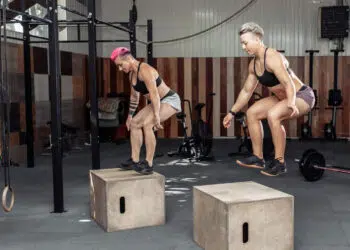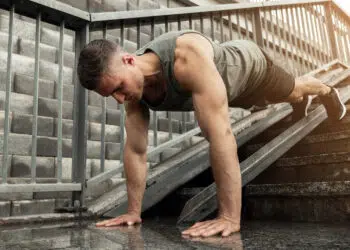It doesn’t matter if you want bigger thighs, a firmer butt, to run faster, or jump higher; weighted squats deserve a place in your workouts. In terms of bang for your buck, they’re pretty much impossible to beat.
That’s why almost every gym on the planet has squat racks, barbells, and space dedicated to the aptly-named king of exercises. A gym without a squat rack is like a car without wheels – pointless!
But what if you work out at home and don’t have access to weights and a squat rack? Does that mean you have to settle for unproductive workouts and substandard leg development?
Not so fast…
While the barbell squat truly is a fantastic exercise, there are plenty of other exercises that come very close and that are suitable for home use.
In this article, we reveal the 15 best home squat alternatives.
Level Up Your Fitness: Join our 💪 strong community in Fitness Volt Newsletter. Get daily inspiration, expert-backed workouts, nutrition tips, the latest in strength sports, and the support you need to reach your goals. Subscribe for free!
The Best Home Squat Alternatives
Friends don’t let friends skip leg day, or so the meme says. Training at home isn’t an excuse to avoid training your lower body. Instead, build the quadriceps, hamstrings, and glutes of your dreams with these home squat alternatives.
1. Air Squats
Air squats, also known as bodyweight squats, are something of a CrossFit staple. Despite using no additional equipment, this exercise still provides an effective lower body workout. However, you may have to do high-rep sets to challenge your leg muscles. That said, for muscular endurance and conditioning, air squats are very hard to beat.
Learn more about this great home squat alternative here.
2. Hindu Squat
The Hindu squat is a variation of the air squat. But, instead of keeping your heels on the floor, you rise up onto your toes as you descend.
This increases quads engagement. Hindu squats also involve a purposeful arm action, which means they work your lower and upper body simultaneously, giving them a useful cardio conditioning effect.
How to do hindu squat:
- Stand with your feet about hip-width apart, toes pointing forward. Raise your arms out in front of you so they’re parallel to the floor. Lengthen your neck and look straight ahead.
- Breathe in and “row” your hands into your shoulders.
- Next, bend your legs and squat down as deep as possible while simultaneously reaching down and back with your arms. Allow your heels to lift off the floor as you descend.
- Raise your arms forward and back up to parallel as you drive your feet into the floor and stand back up. Lower your heels back to the floor as you ascend. Exhale as you return to standing.
- Repeat without pausing.
- Hindu squats should be performed smoothly and in time with your breaths.
2. Goblet Squat
Goblet squats are ideal for home workouts. All you need is a single weight, such as a dumbbell or kettlebell. No barbells or squat rack required! As an added benefit, if you cannot complete a rep, all you need to do is lower the weight to the floor. As such, goblet squats are a very safe exercise, even if you decide to use heavy weights.
Learn more about the mighty goblet squat here.
3. Resistance Band Squat
Resistance bands are ideal for home workouts. Cheap, light, and portable, you can use resistance bands to simulate almost every free-weight and machine exercise you can think of – including squats. As an extra bonus, resistance band exercises also tend to be very joint-friendly, as the tension comes onto your muscles gradually and not all at once as it does with weights.
How to do resistance band squats:
- Stand on the middle of your resistance band with your feet shoulder-width apart. Hold the ends of the band at shoulder height. Brace your core, pull your shoulders down and back, and look straight ahead.
- Bend your knees, push your hips back, and squat down until your thighs are roughly parallel with the floor. Take care not to round your lower back.
- Stand up, so your knees and hips are extended and repeat.
4. Wall Sit Squat
While most exercises involve varying amounts of movement, a few involve no movement at all. These are called isometric or static exercises. During these exercises, your muscles generate force without changing length. Planks are an isometric exercise, as are wall sit squats. Requiring no equipment apart from a smooth, flat wall, this exercise is perfect for home use.
Learn how to do this exercise with our in-depth guide.
5. Stability Ball Squat
A lot of home exercisers own a stability ball. After all, they’re perfect for abs training, and who doesn’t want a leaner, stronger stomach? But stability balls are also great for other exercises. They’re especially useful for leg training. Stability ball squats are a very effective leg exercise, as they guide you through the ideal squatting motion.
How to perform stability ball squats:
- Place a stability ball behind you, so it’s between your lower back and a smooth wall. Lean against the ball and stand with your feet about shoulder-width apart. Move your feet slightly forward and in front of your hips.
- Bend your legs and squat down until your thighs are roughly parallel to the floor. The ball will roll up your back as you descend.
- Drive your feet into the floor and stand back up.
- That’s one rep – keep going!
- Make this exercise more demanding by holding dumbbells in your hands.
6. Squat Jump
Where most types of squats are strength and endurance exercises, squat jumps are more about improving muscle power, which is your ability to generate force quickly. Power is an integral part of most sports. So, if you want to run faster, jump higher, or kick harder, this exercise will help. Best of all, you can do this exercise at home as it requires no additional equipment.
How to do squat jumps:
- Stand with your feet shoulder-width apart. Brace your abs, pull your shoulders down and back, and look straight ahead.
- Bend your legs and squat down, so your thighs are roughly parallel to the floor. Extend your arms behind you as you descend.
- Extend your legs, swing your arms forward and up, and leap into the air as high as possible.
- Land on slightly bent legs to absorb the impact and then descend into another rep.
Level Up Your Fitness: Join our 💪 strong community in Fitness Volt Newsletter. Get daily inspiration, expert-backed workouts, nutrition tips, the latest in strength sports, and the support you need to reach your goals. Subscribe for free!
7. Paused Squat
One of the main disadvantages of training your legs at home is the lack of available weight. Once you’ve developed a reasonable level of strength, some bodyweight exercises may become too easy. One way around this problem is to do paused reps. You can apply paused reps to most bodyweight leg exercises, but they work particularly well with squats.
How to do Paused Squats:
- Stand with your feet shoulder-width apart, toes turned slightly outward. Pull your shoulders down and back and brace your core. Look straight ahead.
- Bend your knees, push your hips back, and squat down until your thighs are roughly parallel to the floor.
- Without relaxing, hold this position for 3-5 seconds.
- Stand up and repeat.
- Increase the length of the pause to make this exercise harder. You can also do it with weights, i.e., goblet squats.
8. Sissy Squats
If regular bodyweight squats aren’t hard enough, this is the exercise for you. Sissy squats put your muscles and joints in a much less efficient position, making them far more demanding. As such, even done with just your body weight, sissy squats are a superb bodybuilding exercise.
How to do sissy squats:
- Stand next to a wall or some other object you can use for balance.
- Rise up onto your tiptoes.
- Push your hips and knees forward and squat down as you simultaneously lean back. Descend as far as you can, ideally until your shins are roughly parallel to the floor.
- Drive your toes into the floor and stand back up.
- Tense your quads and glutes at the top of each rep and repeat.
- You can also do weighted sissy squats.
9. Split Squat
When you do squats, your weight is (or should be!) distributed evenly between your feet. Split squats increase the load on your front leg, so your weight is spread 60-40, forcing your muscles to do a little more work. This is a good exercise for overloading your quadriceps without using dumbbells, kettlebells, or a barbell.
Learn how to do split squats here.
10. Forward Lunges
Like split squats, forward lunges increase the load on your front leg. They’re also good for developing better coordination, balance, and mobility. Lunges can be done using a barbell or dumbbells, but they’re also a useful bodyweight-only leg exercise. Lunges are especially beneficial for runners, athletes, and anyone looking for a functional lower body workout.
Read more about forward lunges here.
11. Reverse Lunges
Where forward lunges tend to emphasize your quadriceps, reverse lunges are a little more glute and hamstring-centric. They’re also easier on your knees than forward lunges. However, despite moving backward instead of forward, reverse lunges are still good for improving your balance, coordination, and mobility.
Learn how to do reverse lunges here.
12. Step-Through Lunges
This exercise combines forward and reverse lunges into one awesome movement. It’s a demanding exercise that requires good balance and coordination. Because of the increased time under tension, this exercise is useful for anyone looking to make lunges more challenging but doesn’t want to use weights.
How to do it:
- Stand tall with your feet together and your hands by your sides. Look straight ahead and not down at the floor. Brace your abs.
- Take a large step backward, bend your legs, and lower your rear knee down to within an inch of the floor.
- Push off your back leg and step out into a forward lunge. Do not “touch down” as you move between backward and forward lunges.
- Push off your front leg and move into another reverse lunge.
13. Bulgarian Split Squat
No one is sure why Bulgarian split squats are called Bulgarian split squats. They don’t come from Bulgaria, and they’re not even associated with Bulgarian athletes or bodybuilders. For that reason, a lot of people prefer to call this exercise Rear Foot Elevated Split Squats or RFESS for short.
Ultimately, it doesn’t matter what you call this exercise; it’s still one of the best lower-body moves you can do. With or without weights, this is an excellent home squat alternative.
How to do Bulgarian split squat:
- Stand with your back to a knee-high exercise bench. No bench? Use a chair or even your sofa.
- Bend one leg, place the top of your foot on the bench behind you, and hop forward and into a split stance.
- Bend your legs and lower your rear knee down toward the floor. Keep your lower back straight and your chest and head up. Look straight ahead. Try to keep your front shin close to vertical, and do not let your knee move beyond your toes.
- Push down through your front leg and stand back up. You should feel that about 60% of your weight is on your front leg, and about 40% is on your rear leg.
- Do the same number of reps on each leg.
Learn all there is to know about Bulgarian split squats in our detailed guide.
14. High Step-ups
High step-ups are a little like lunges, but instead of moving horizontally across the ground, you move vertically. This means you’ve got to lift a bit more weight, making this exercise a little more demanding than lunges. So, while you can do step-ups with a low step, they’re much more challenging if you use a knee-high step. This will increase your range of motion and muscle engagement.
How to do it:
- Stand a couple of feet behind a box, sturdy bench, or step. Start with something about knee height and then increase as you get stronger.
- Starting with your feet together, bend one leg and place your foot on top of the platform. Drive your foot into the top of your platform and stand up on top. Try not to push off your trailing leg. Let your lead leg do most the work.
- Step down with the same leg and then switch, so you’re leading with the opposite foot.
- Continue alternating legs for the required number of reps.
15. Box Jumps
Squats jumps (exercise #6) are a great exercise, but they also involve a lot of impact. After all, what goes up must come down, right? Box jumps involve jumping up but then landing on a raised platform, which means less impact and a safer workout. This is a good option if you’ve got painful knees or hips, or are overweight.
How to do it:
- Stand a couple of feet behind a strong box, sturdy bench, or stable step. Start with something about knee height and increase only when you’ve mastered the basic movement. Your feet should be between shoulder and hip-width apart.
- Bend your knees and swing your arms behind you.
- Swing your arms forward and jump up onto the platform. Land with your knees slightly bent to minimize the shock of landing.
- Step down to the floor, reset your feet, and repeat.
More Squat Alternative Exercises:
- Front Squat Alternatives for Mass, Strength
- Hack Squat Alternative for Bigger, Stronger Legs
- Smith Machine Squat Alternatives for Powerful, Muscular Legs
- Bulgarian Split Squat Alternatives for Stronger, More Athletic Legs
Home Squat Alternatives
If you can do barbell squats, then you probably should. After all, squats are the crowned king of lower body exercises. Entire workouts have been written around squats. Whether you want bigger thighs, get stronger, get leaner, or improve your athletic performance, squats will help.
But, if you work out at home, you may not have a squat rack, so you’ll need some alternative exercises. After all, the last thing you want to do is skip leg day, right?
Use any of these home squat alternatives to develop legs you can be proud of. Most require no additional equipment, and those that do only need a dumbbell, kettlebell, resistance band, or step.
Interested in measuring your progress? Check out our strength standards for Smith Machine Squat, Bulgarian Split Squat, Bodyweight Squat, and more.








